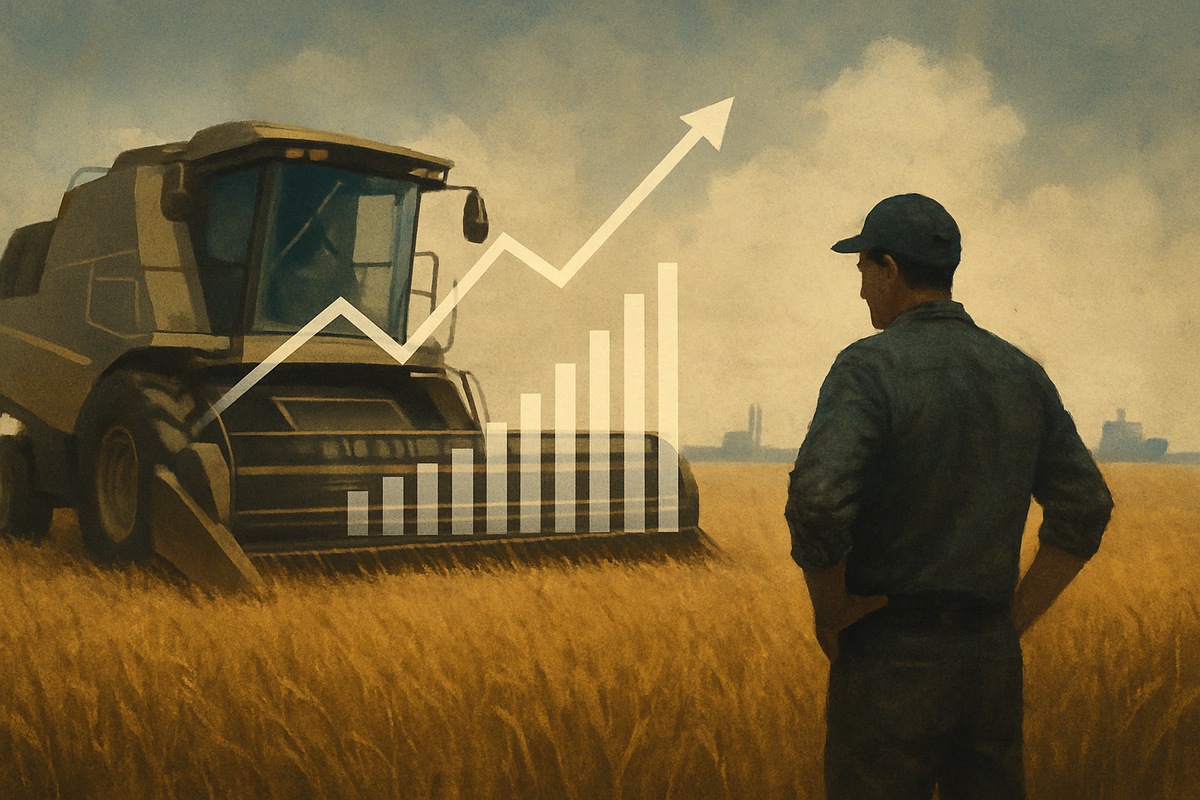
As of October 22, 2025, the specter of President Trump's trade policies once again looms large over the American agricultural sector, threatening to push farm input costs to unprecedented levels and casting a long shadow over farmer profitability. Following a tumultuous period between 2018 and 2020 marked by escalating trade wars and retaliatory tariffs, farmers are now bracing for a potential resurgence of these policies. The previous era saw significant increases in the cost of essential farming materials—from steel and aluminum for machinery to fertilizers and chemicals—directly impacting the financial health of countless agricultural operations. With renewed discussions of broad tariffs, the industry faces a critical juncture, prompting concerns about sustained market disruptions, diminished competitiveness, and the long-term viability of family farms.
A Resurgent Storm: Tariffs Drive Up the Cost of Cultivation
The current alarm bells ringing across the agricultural landscape are a stark reminder of the challenges faced by American farmers during President Trump's previous administration. The core of these policies involved the imposition of tariffs, primarily under Section 232 on steel and aluminum imports, and Section 301 against China. These actions, initiated in March 2018, triggered a cascade of retaliatory tariffs from major trading partners, most notably China, which targeted crucial U.S. agricultural exports like soybeans, pork, corn, and wheat. While these trade disputes aimed to protect domestic industries, they inadvertently created a double-edged sword for agriculture: diminishing export markets while simultaneously inflating the cost of doing business.
The timeline of events saw steel and aluminum tariffs in early 2018 directly increasing the manufacturing costs for farm machinery and parts. Initial estimates suggested at least a 6% increase, with some reports indicating a staggering 78% rise in domestic equipment production costs during the 2018 trade war. Simultaneously, China's retaliatory tariffs, sometimes exceeding 25% on U.S. agricultural goods, led to a dramatic reduction in demand and plummeting commodity prices. Key players involved included the U.S. Department of Agriculture (USDA), which rolled out the Market Facilitation Program (MFP) providing over $20 billion in aid to farmers, and major agricultural commodity traders who had to navigate rapidly shifting global supply chains. The initial market reaction was one of significant uncertainty, a sharp decline in farm income, and a surge in farm bankruptcies, which increased by 24% from 2018 to 2019, reaching levels not seen in nearly a decade. For 2025, the concerns are amplified, with reports indicating an average effective tariff rate on agricultural inputs jumping from 1% to 12%, and specific items like pesticides, tractors, and fertilizers seeing increases of 16-39% or even higher.
Corporate Crossroads: Winners and Losers in a Tariff-Laden Market
The resurgence of tariff-driven cost increases presents a complex financial environment, creating distinct winners and losers among public companies operating within and around the agricultural sector.
On the losing side, companies heavily reliant on imported raw materials, particularly steel and aluminum, for their manufacturing processes are likely to face significant headwinds. Agricultural machinery giants such as Deere & Company (NYSE: DE) and CNH Industrial N.V. (NYSE: CNHI), which produce tractors, combines, and other vital farm equipment, will likely see their input costs rise, potentially leading to increased production expenses and pressure on profit margins. While they may pass some of these costs onto farmers, this could further dampen demand in an already strained market. Similarly, companies involved in the production of fertilizers and chemicals, like Nutrien Ltd. (TSX: NTR, NYSE: NTR) and Mosaic Company (NYSE: MOS), could face higher costs for imported components or face tariffs on their own products if they source internationally. Increased tariffs on Canadian fertilizer, for instance, directly impact the cost structure of these producers. These companies may struggle to maintain competitive pricing, potentially impacting sales volumes and market share.
Conversely, some companies might find themselves in a relatively advantageous position. Domestic suppliers of raw materials, particularly steel and aluminum producers like Nucor Corporation (NYSE: NUE) and Cleveland-Cliffs Inc. (NYSE: CLF), could see increased demand and potentially higher pricing power due to reduced foreign competition, although the overall economic impact on their agricultural customers remains a concern. Furthermore, companies with robust domestic supply chains or those that can quickly pivot to alternative, tariff-free sourcing might mitigate some of the negative impacts. However, the broader agricultural downturn caused by higher input costs and reduced farmer profitability could ultimately suppress demand across the entire sector, even for these potential "winners." The financial strain on farmers also impacts agricultural lenders and insurers, potentially leading to higher loan defaults or increased claims, affecting institutions like Farm Credit System lenders, though they are not publicly traded.
Broader Implications: Reshaping the Agricultural Landscape
The renewed threat of rising farm input costs due to trade policies is not merely an isolated financial challenge; it represents a significant disruption that could reshape the broader agricultural landscape, influencing industry trends, supply chains, and policy discussions for years to come.
This event fits into a broader trend of increasing protectionism and geopolitical tensions, which often disproportionately impact commodity-dependent sectors like agriculture. The ripple effects extend far beyond the farm gate. Processors and food companies, such as Archer-Daniels-Midland Company (NYSE: ADM) and Bunge Global SA (NYSE: BG), which rely on stable and affordable agricultural raw materials, could face increased sourcing costs. This, in turn, could lead to higher food prices for consumers, creating inflationary pressures across the economy. Partners in the supply chain, from transportation and logistics companies to retailers, will also feel the squeeze as volumes and profit margins are affected. Regulatory and policy implications are significant, as farmers will likely intensify calls for government intervention, whether in the form of new aid packages, tariff exemptions, or trade negotiations to alleviate the burden. This could reignite debates about the efficacy of protectionist trade policies versus the benefits of open markets. Historically, similar events, such as the agricultural crises of the 1980s, demonstrated how a combination of high input costs, low commodity prices, and trade disruptions can lead to widespread financial distress and structural changes in the farming industry. The previous Trump-era trade war already caused a lasting realignment of global supply chains, with countries like China diversifying their agricultural imports away from the U.S., a shift that has not fully reversed by 2025.
The Road Ahead: Navigating Uncertainty
Looking ahead, the agricultural sector faces a period of profound uncertainty, with both short-term challenges and long-term strategic adjustments on the horizon.
In the short term, farmers will likely prioritize cost-cutting measures, seeking more efficient use of inputs, delaying equipment upgrades, and exploring alternative suppliers where possible. This could lead to a temporary dip in demand for new machinery and premium-priced inputs. Government responses will be critical; whether through renewed aid programs or diplomatic efforts to de-escalate trade tensions, policy decisions will heavily influence the immediate financial health of farms. In the long term, the industry may see accelerated adoption of precision agriculture technologies to optimize input usage and reduce waste, a strategic pivot driven by economic necessity. Farmers might also explore diversification of crops or markets to reduce reliance on specific commodities vulnerable to trade disputes. Market opportunities could emerge for companies offering cost-effective, innovative solutions for input efficiency or those facilitating direct-to-consumer sales channels. However, the overarching challenge remains the potential for sustained high input costs coupled with volatile commodity prices, leading to continued narrow or negative profit margins. Potential scenarios range from a rapid de-escalation of trade tensions, offering a path to recovery, to a prolonged period of protectionism, forcing fundamental restructuring within the agricultural sector and potentially accelerating consolidation as smaller, less resilient farms exit the market.
Final Harvest: Assessing the Lasting Impact
In summary, President Trump's trade policies, specifically the imposition of tariffs leading to increased farm input costs, represent a significant and ongoing challenge for American agriculture as of late 2025. The key takeaways from this evolving situation are the persistent financial strain on farmers due to elevated costs for machinery, fertilizers, and chemicals; the lasting shifts in global agricultural trade patterns; and the renewed reliance on government aid to buffer economic hardship.
Moving forward, the market will likely remain volatile, with commodity prices susceptible to geopolitical developments and supply chain disruptions. The agricultural sector's resilience will be tested, demanding strategic adaptations and a renewed focus on efficiency and market diversification. The lasting impact could be a more consolidated industry, a greater push towards technological innovation in farming, and a heightened awareness among policymakers about the delicate balance between trade protectionism and the economic viability of critical sectors. Investors should closely watch for any policy shifts regarding tariffs, the performance of agricultural input suppliers (e.g., Deere & Company (NYSE: DE), Nutrien Ltd. (TSX: NTR, NYSE: NTR)), and the overall financial health of publicly traded food processors and commodity traders (e.g., Archer-Daniels-Midland Company (NYSE: ADM), Bunge Global SA (NYSE: BG)) in the coming months. The ability of these companies to navigate rising costs and potentially reduced farmer purchasing power will be a key determinant of their success in this turbulent environment.
This content is intended for informational purposes only and is not financial advice






